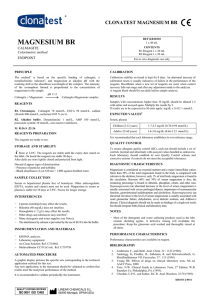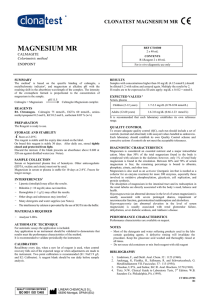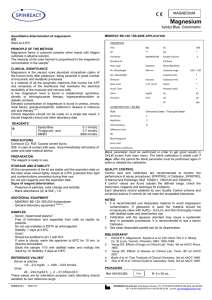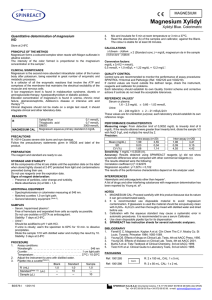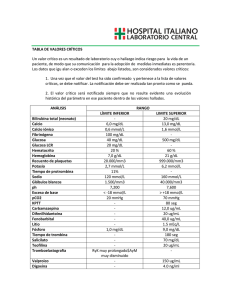magnesium br - LINEAR CHEMICALS
Anuncio
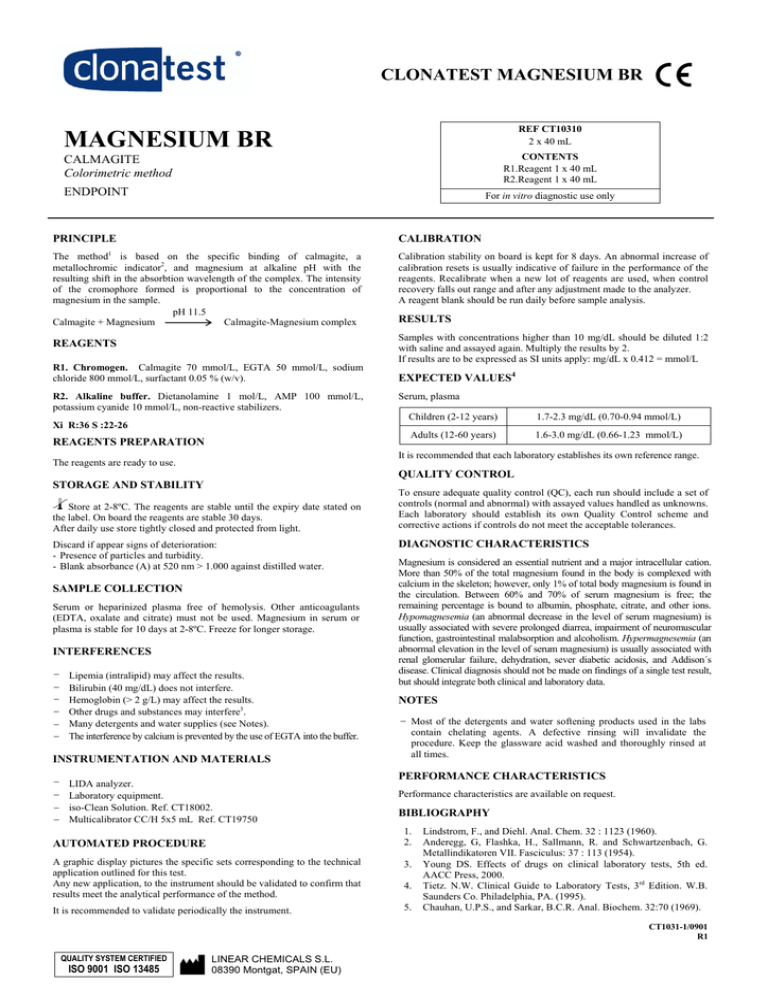
CLONATEST MAGNESIUM BR REF CT10310 2 x 40 mL MAGNESIUM BR CONTENTS R1.Reagent 1 x 40 mL R2.Reagent 1 x 40 mL CALMAGITE Colorimetric method ENDPOINT For in vitro diagnostic use only PRINCIPLE CALIBRATION 1 The method is based on the specific binding of calmagite, a metallochromic indicator2, and magnesium at alkaline pH with the resulting shift in the absorbtion wavelength of the complex. The intensity of the cromophore formed is proportional to the concentration of magnesium in the sample. pH 11.5 Calmagite + Magnesium Calmagite-Magnesium complex Calibration stability on board is kept for 8 days. An abnormal increase of calibration resets is usually indicative of failure in the performance of the reagents. Recalibrate when a new lot of reagents are used, when control recovery falls out range and after any adjustment made to the analyzer. A reagent blank should be run daily before sample analysis. RESULTS Samples with concentrations higher than 10 mg/dL should be diluted 1:2 with saline and assayed again. Multiply the results by 2. If results are to be expressed as SI units apply: mg/dL x 0.412 = mmol/L REAGENTS R1. Chromogen. Calmagite 70 mmol/L, EGTA 50 mmol/L, sodium chloride 800 mmol/L, surfactant 0.05 % (w/v). R2. Alkaline buffer. Dietanolamine 1 mol/L, AMP 100 mmol/L, potassium cyanide 10 mmol/L, non-reactive stabilizers. EXPECTED VALUES4 Serum, plasma Children (2-12 years) 1.7-2.3 mg/dL (0.70-0.94 mmol/L) Adults (12-60 years) 1.6-3.0 mg/dL (0.66-1.23 mmol/L) Xi R:36 S :22-26 REAGENTS PREPARATION It is recommended that each laboratory establishes its own reference range. The reagents are ready to use. QUALITY CONTROL STORAGE AND STABILITY Store at 2-8ºC. The reagents are stable until the expiry date stated on the label. On board the reagents are stable 30 days. After daily use store tightly closed and protected from light. Discard if appear signs of deterioration: - Presence of particles and turbidity. - Blank absorbance (A) at 520 nm > 1.000 against distilled water. SAMPLE COLLECTION Serum or heparinized plasma free of hemolysis. Other anticoagulants (EDTA, oxalate and citrate) must not be used. Magnesium in serum or plasma is stable for 10 days at 2-8ºC. Freeze for longer storage. INTERFERENCES − − − − − − Lipemia (intralipid) may affect the results. Bilirubin (40 mg/dL) does not interfere. Hemoglobin (> 2 g/L) may affect the results. Other drugs and substances may interfere3. Many detergents and water supplies (see Notes). The interference by calcium is prevented by the use of EGTA into the buffer. INSTRUMENTATION AND MATERIALS − − − − LIDA analyzer. Laboratory equipment. iso-Clean Solution. Ref. CT18002. Multicalibrator CC/H 5x5 mL Ref. CT19750 To ensure adequate quality control (QC), each run should include a set of controls (normal and abnormal) with assayed values handled as unknowns. Each laboratory should establish its own Quality Control scheme and corrective actions if controls do not meet the acceptable tolerances. DIAGNOSTIC CHARACTERISTICS Magnesium is considered an essential nutrient and a major intracellular cation. More than 50% of the total magnesium found in the body is complexed with calcium in the skeleton; however, only 1% of total body magnesium is found in the circulation. Between 60% and 70% of serum magnesium is free; the remaining percentage is bound to albumin, phosphate, citrate, and other ions. Hypomagnesemia (an abnormal decrease in the level of serum magnesium) is usually associated with severe prolonged diarrea, impairment of neuromuscular function, gastrointestinal malabsorption and alcoholism. Hypermagnesemia (an abnormal elevation in the level of serum magnesium) is usually associated with renal glomerular failure, dehydration, sever diabetic acidosis, and Addison´s disease. Clinical diagnosis should not be made on findings of a single test result, but should integrate both clinical and laboratory data. NOTES − Most of the detergents and water softening products used in the labs contain chelating agents. A defective rinsing will invalidate the procedure. Keep the glassware acid washed and thoroughly rinsed at all times. PERFORMANCE CHARACTERISTICS Performance characteristics are available on request. BIBLIOGRAPHY 1. 2. AUTOMATED PROCEDURE A graphic display pictures the specific sets corresponding to the technical application outlined for this test. Any new application, to the instrument should be validated to confirm that results meet the analytical performance of the method. 3. It is recommended to validate periodically the instrument. 5. 4. Lindstrom, F., and Diehl. Anal. Chem. 32 : 1123 (1960). Anderegg, G, Flashka, H., Sallmann, R. and Schwartzenbach, G. Metallindikatoren VII. Fasciculus: 37 : 113 (1954). Young DS. Effects of drugs on clinical laboratory tests, 5th ed. AACC Press, 2000. Tietz. N.W. Clinical Guide to Laboratory Tests, 3rd Edition. W.B. Saunders Co. Philadelphia, PA. (1995). Chauhan, U.P.S., and Sarkar, B.C.R. Anal. Biochem. 32:70 (1969). CT1031-1/0901 R1 QUALITY SYSTEM CERTIFIED ISO 9001 ISO 13485 LINEAR CHEMICALS S.L. 08390 Montgat, SPAIN (EU) CLONATEST MAGNESIUM BR REF CT10310 2 x 40 mL MAGNESIO BR CONTENIDO R1.Reactivo 1 x 40 mL R2.Reactivo 1 x 40 mL CALMAGITA Método colorimétrico PUNTO FINAL Sólo para uso diagnóstico in vitro FUNDAMENTO CALIBRACION El método1 está basado en la unión específica de la calmagita, un indicador metalocrómico2, con el magnesio a un pH alcalino con el consiguiente desplazamiento del espectro de absorción del complejo. La intensidad del cromóforo formado es proporcional a la concentración del magnesio presente en la muestra. pH 11,5 Complejo Calmagita-Magnesio Calmagita + Magnesio La estabilidad de calibración con los reactivos dispuestos en abierto es de 8 días. Un aumento anormal en la frecuencia de calibración esta generalmente asociada a un fallo de funcionalidad de los reactivos. Recalibrar al emplear un lote nuevo de reactivos, cuando los valores control se hallan fuera de rango y tras cualquier ajuste realizado en el instrumento. Realizar un blanco diariamente antes de analizar las muestras. CALCULOS REACTIVOS R1. Cromógeno. Calmagita 70 mmol/L, EGTA 50 mmol/L, sodio cloruro 800 mmol/L, tensioactivos 0,05%. R2. Tampón alcalino. Dietanolamina 1 mol/L, AMP 100 mmol/L, potasio cianuro 10 mmol/L, estabilizantes no-reactivos. Muestras con concentraciones de magnesio superiores a 10 mg/dL se diluyen 1:2 con solución salina y repetir el ensayo. Multiplicar los resultados por 2. Para expresar los resultados en unidades SI aplicar: mg/dL x 0,412 = mmol/L VALORES DE REFERENCIA4 Suero, plasma Xi R:36 S :22-26 PREPARACION DE LOS REACTIVOS Niños (2-12 años) 1,7-2,3 mg/dL (0,70-0,94 mmol/L) Adultos (12-60 años) 1,6-3,0 mg/dL (0,66-1,23 mmol/L) Los reactivos están listos para su uso. Se recomienda que cada laboratorio establezca su propio rango de referencia. ALMACENAMIENTO Y ESTABILIDAD CONTROL DE CALIDAD Conservar a 2-8ºC. Los reactivos son estables hasta la fecha de caducidad indicada en la etiqueta. En el analizador es estable 30 días. Tras su uso diario, mantener los reactivos cerrados y protegidos de la luz. Para un control de calidad (CC) adecuado, se incluirán en cada serie controles valorados (normal y abnormal) que se tratarán como muestras problema. Cada laboratorio debe establecer su propio Control de Calidad y sus medidas correctoras cuando los controles no cumplan con las tolerancias exigidas. Descartar si se observan signos de deterioro: - Presencia de partículas y turbidez. - Absorbancia del Blanco (A) a 520 > 1.000 frente agua destilada. MUESTRAS Suero o plasma heparinizado libre de hemólisis. No usar otros anticoagulantes (EDTA, oxalato y citrato). El magnesio sérico o plasmático es estable 10 días 2-8ºC. Congelar para una conservación más prolongada. INTERFERENCIAS − − − − − − Lipemia (intralipid) puede afectar los resultados. Bilirrubina (40 mg/dL) no interfiere. Hemoglobina (> 2 g/L) puede afectar los resultados. Otros medicamentos y sustancias pueden interferir3. Detergentes y suministros de agua de laboratorio (ver Notas). La interferencia del calcio se evita adicionando EGTA en el reactivo. EQUIPO ADICIONAL − − − − Analizador LIDA. Material de laboratorio. iso-Clean Solution. Ref. CT18002. Multicalibrator CC/H 5x5 mL Ref. CT19750 SIGNIFICADO CLINICO El magnesio está considerado como un nutriente esencial y un catión intracelular de primer orden. Más del 50% del magnesio total forma parte junto con el calcio de la sustancia mineral ósea y sólo el 1% del magnesio total corporal se halla en la circulación. Entre el 60% y el 70% del magnesio en el plasma se encuentra en forma libre mientras que el porcentaje restante permanece unido a la albúmina, fosfato, citrato, y otros iones. La hipomagnesemia (bajo nivel de magnesio en el suero) está generalmente asociada a una alteración neuromuscular, prolongadas diarreas, síndrome de malabsorción intestinal y alcoholismo. La hipermagnesemia (elevado nivel de magnesio en el suero) está asociada con el fallo glomerular renal, deshidratación, acidosis diabética severa y enfermedad de Addison. El diagnóstico clínico no debe realizarse con los resultados de un único ensayo sin atender los datos clínicos del paciente. NOTAS − La mayoría de detergentes y productos de tratamiento de aguas empleados en los laboratorios contienen agentes quelantes. Un enjuague defectuoso invalida el procedimiento. Mantener en todo momento el material de vidrio lavado al ácido y enjuagado a fondo. CARACTERISTICAS ANALITICAS Las características analíticas están disponibles bajo solicitud. REFERENCIAS TECNICA AUTOMATICA Una representación grafica visualiza los ajustes específicos correspondientes a la aplicación técnica diseñada para este ensayo. Cualquier aplicación nueva al instrumento deberá validarse para confirmar que los resultados cumplen las características del método. Se recomienda validar periódicamente el instrumento. 1. 2. 3. 4. 5. QUALITY SYSTEM CERTIFIED ISO 9001 ISO 13485 LINEAR CHEMICALS S.L. 08390 Montgat, SPAIN (EU) Lindstrom, F., y Diehl. Anal. Chem. 32 : 1123 (1960). Anderegg, G, Flashka, H., Sallmann, R. y Schwartzenbach, G. Metallindikatoren VII. Fasciculus: 37 : 113 (1954). Young DS. Effects of drugs on clinical laboratory tests, 5th ed. AACC Press, 2000. Tietz. N.W. Clinical Guide to Laboratory Tests, 3rd Edition. W.B. Saunders Co. Philadelphia, PA. (1995). Chauhan, U.P.S., y Sarkar, B.C.R. Anal. Biochem. 32:70 (1969).
